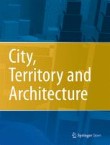City, Territory and Architecture welcomes submissions to the thematic series - The "City of Proximity" to boost environmental sustainability and urban resilience, according to a salutogenic approach
Starting from the Healthy Cities and Urban Health definitions, the concept of the “City of proximity” raises a series of issues also connected to the COVID-19 pandemic, that is an accelerator of the on-going urban emergencies in terms of social / Public Health / environmental issues and well-being. Considering the lack of the systemic comparison between epidemiological and urban data: recent scientific studies were aimed to investigate the relationship between the built environment and health, trying to define evidence and bring useful outcomes, but research that quantifies, at the statistical and epidemiological level, the direct health impacts, are limited. There is a need to develop research aimed at a better understanding of the mechanisms that link the built environment to the multiple dimensions of health in order to identify practical actions (and mode of governance) that can be easily appropriated by cities and thus help them to place health and environmental issues at the centre of their development and urban planning choices.
The key concept of the “City of proximity” is a useful vision to represent the priviledge place where it's possible to meet the needs for sustainable, fair, quality, and healthy living. The dimension of proximity can be central to formulating strategies to improve the quality of urban life. Still, it can also play a role in constructing forms of intervention to improve public health and in ordinary conditions, both in extraordinary and emergency conditions. For these reasons, the “City of proximity” become the place to bridge Healthy Cities' strategies to the 11th SDG's Targets titled "Sustainable Cities and Communities. Make cities and human settlements inclusive, safe, resilient and sustainable".
In this scenario, the current challenge is to explore which urban planning and design strategies deliver the best results in compliance with the following general criteria: available scientific evidence and their impacts on the urban conditions, health and wellbeing; key case studies; health, environmental and strategic impact assessment’s experiences; how these practices are related to the 11th SDG’s seven targets.
The Thematic Series "The "City of proximity" to boost environmental sustainability and urban resilience, according to a salutogenic approach" encourages the multidisciplinary approach between different expertise and stakeholders - like Public Health experts, transport and urban planners, designers and decision makers - following the final purpose to collect experiences, researches, policies and practices in the field.
Submission Instructions
Before submitting your manuscript, please ensure you have carefully read the submission guidelines for City, Territory and Architecture. The complete manuscript should be submitted through the City, Territory and Architecture submission system. To ensure that you submit to the correct thematic series please select the appropriate thematic series in the drop-down menu upon submission. In addition, indicate within your cover letter that you wish your manuscript to be considered as part of the thematic series on The "City of Proximity". All submissions will undergo rigorous peer review and accepted articles will be published within the journal as a collection.
Lead Guest Editors
Stefano Capolongo, Department of Architecture, Built environment and Construction engineering (ABC) Politecnico di Milano, Italy
Marco Dettori, Department of Medical, Surgical and Experimental Sciences University of Sassari, Italy
Anne Roue Le Gall, Department of environmental and occupational health Ecole des hautes études en santé publique (EHESP), France
Submissions will also benefit from the usual advantages of open access publication:
- Rapid publication: Online submission, electronic peer review and production make the process of publishing your article simple and efficient.
- High visibility and international readership in your field: Open access publication ensures high visibility and maximum exposure for your work - anyone with online access can read your article
- No space constraints: Publishing online means unlimited space for figures, extensive data and video footage
- Authors retain copyright, licensing the article under a Creative Commons license: articles can be freely redistributed and reused as long as the article is correctly attributed
For editorial enquiries please contact editorial@cityterritoryarchitecture.com.
Sign up for article alerts to keep updated on articles published in City, Territory and Architecture - including articles published in this thematic series!
